Posted By admin on April 21, 2019
Sanchez Wins Air Rifle Gold at National Junior Olympic Shooting Championships
Colorado Springs, April 11, 2019
Matthew Sanchez picked up his second medal this week at the National Junior Olympic Shooting Championships (NJOSC), but this time he was atop the podium today, winning gold in Men’s Air Rifle at the Olympic Shooting Center in Colorado Springs.

Matthew Sanchez, Air Rifle National Junior Olympic Champion 2019
The high school junior from Tampa, Florida entered the Final with the highest two-day Qualification score of 1245.8 Though he finished in seventh place in today’s Final (Additional points – four for first, 3.5 for second, three for third and so on – were awarded based on finish in the Final), Sanchez was able to keep the gold from Finals winner and eventual silver medalist Jared Eddy (Midland, Georgia), who shot an impressive Finals score of 247.2.
The West Virginia freshman’s Finals win also featured three, 10.9 shots – two of them occurring in a row. A 10.9 is a perfect shot in international rifle or pistol. As this was a selection match for the International Shooting Sport Federation (ISSF) Junior World Cup in Germany this summer, all athletes shot two Qualification matches and were selected for the Final based on cumulative points. Medals were awarded on the total points from Qualification and Finals finish.
“I had a little trouble with air right before the match, but I managed to sort things out,” Sanchez said. “Once the first day hit, I had my stuff together and was able to put up a really good score.” Sanchez, 16, departs for Beijing, China in one week where he will compete in the ISSF World Cup.

Matthew Sanchez, Air Rifle, National Junior Olympic Champion
“This was like my third or fourth time out here and I remember coming in first as a J3,” Sanchez said. “I was looking at all these people and seeing how good the competition was, then fast forward a couple years to now, I’m now one of the top-10 consistently and it’s been a long journey! It’s definitely been a good, long trip and I was feeling good for this one after the Spring Selection Match.”
Air Force Academy sophomore Nate Peterson (Sharpsburg, Georgia) finished second in the Final and took the bronze medal overall. The top-three overall finishers not only won medals, but appointments to the National Junior Team, along with their berths at the ISSF Junior World Cup.
Sanchez also won silver in the Men’s Three-Position Rifle event on Tuesday. He also won silver in Men’s Air Rifle at last year’s NJOSC.
Winning gold in the J2 (age 15-17) classification awards were Scott Rockett (Cary, North Carolina) for gold, Phillip Becker (Granbury, Texas) for silver and Gavin Barnick (Mora, Minnesota) for bronze.
In the J3 (ages 14 and younger) category, Braden Peiser (San Angelo, Texas) won gold, Logan Michael (Lincoln, California)won silver and Marcus Klemp (Missoula, Montana) won bronze.
The 172 athletes competing in Men’s Air Rifle won their chance to compete at NJOSC because of their finishes at the state-level Junior Olympic matches. Overall, 607 athletes from 48 states will compete in Rifle, Pistol and Paralympic events throughout the three-week NJOSC. The NJOSC features the top 34 percent of all competitors in 2019 and will feature invitees that either won their state championship or were selected based on a score they attained. The competitors range in age from nine to 20 years old.
Complete results, start lists and more information about the NJOSC program: http://www.usashooting.org/7-events/njosc/njoscrifle.
View and download images from the Men’s Air Rifle competition at NJOSC: https://flic.kr/s/aHskQpM4RB.
Fiori Repeats as National Junior Olympic Champion
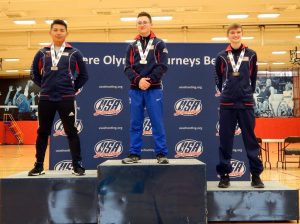
Peter Fiori wins gold medal on the first day of the National Junior Olympic Championships
Colorado Springs, April 9th, 2019
The first medals of the National Junior Olympic Shooting Championships (NJOSC) for Rifle and Pistol were awarded today in the Men’s Three-Position Rifle competition at the Olympic Shooting Center in Colorado Springs.
Winning the gold medal today was defending NJOSC champion and Air Force Academy freshman Peter Fiori, Jr. (Lebanon, New Jersey). As this is a selection match for the International Shooting Sport Federation (ISSF) Junior World Cup in Germany this summer, all athletes shot two Qualification matches and were selected for the Final based on cumulative points. Additional points (eight for first, seven for second and so on) were awarded based on finish in the Final. By a dominating 14-point margin, Fiori had already locked down the gold, even before the Finals. During his second day of Qualification, Fiori shot a score of 1178 – a world-class score at the Open (adult) level and a new National Junior Record to give him the points for the win.

Peter Fiori wins gold the first day of the National Junior Olympic Championships
“My second day of Qualification was 23-points higher than the first!” said Fiori. “I have no idea what was working. I had a test at 6:30 in the morning that day and was really tired, and I just kind of showed up to the match and it just worked! I don’t know. It’s a personal best too, so maybe I need to take more tests at 6:30 in the morning?” Fiori joked.
Also sealing the silver medal before the Final was Matthew Sanchez (Tampa, Florida) with a two-day cumulative score of 2325. Sanchez will leave for China next week to compete in the ISSF World Cup in Beijing.
The bronze medal was determined by finish in today’s final and went to University of Alaska Fairbanks freshman Kellen McAferty (Little Rock, Washington), who won the Final. The top-three overall finishers not only won medals, but appointments to the National Junior Team, along with their berths at the ISSF Junior World Cup in Germany this summer.
Winning the J2 (age 15-17) classification awards were Scott Rockett (Cary, North Carolina) for gold, Kyle Kutz (Darien, Connecticut) for silver and Philip Becker (Granbury, Texas) for bronze.
In the J3 (ages 14 and younger) category, Braden Peiser (San Angelo, Texas) won gold, Griffin Lake (Emmaus, Pennsylvania) won silver and Nathan Engman (Albertville, Minnesota) won bronze.
The 61 athletes in Men’s Three-Position rifle won their chance to compete at NJOSC due to their finishes at the state-level Junior Olympic matches. Overall, 607 athletes from 48 states will compete in Rifle, Pistol and Paralympic events throughout the three-week NJOSC. The NJOSC features the top 34 percent of all competitors in 2019 and will feature invitees that either won their state championship or were selected based on a score they attained. The competitors range in age from nine to 20 years old.
Complete results start lists and more information about the NJOSC program: http://www.usashooting.org/7-events/njosc/njoscrifle.
View and download images from the Men’s Three-Position Rifle competition from NJOSC: https://flic.kr/s/aHskQkuN3D.
Way Wins Air Rifle at National Junior Olympic Shooting Championships
Colorado Springs, April 15. 2019
That’s what local athlete Macey Way proclaimed today after winning gold in Women’s Air Rifle at the National Junior Olympic Shooting Championships (NJOSC) at the Olympic Shooting Center in Colorado Springs.
Way, 17, won her first overall medal at NJOSC on her home range before the Final even began, posting two impressive Qualification scores of 623.9 and 623.7. With the two-day total of 1247.6, Way had already put the gold medal out of reach for anyone else, regardless of her finish in the Final. (Additional points – four for first, 3.5 for second, three for third and so on – were awarded based on finish in the Final. )
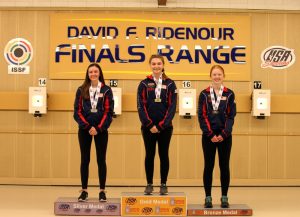
Macey Way wins air rifle at 2019 National Junior Olympic Championships
As this was a selection match for the International Shooting Sport Federation (ISSF) Junior World Cup in Germany this summer, all athletes shot two Qualification matches and were selected for the Final based on cumulative points. Medals, National Junior Team appointments and slots on the team going to Germany were awarded on the total points from Qualification and Finals finish.
“I was so nervous, even going into Finals because it’s the most fun part of all the matches!” said Way. “I just really wanted to do well, but in the months before this I just trained, and I trained, and I tried to get coaching from everyone I could that was bigger than me or that I knew, and I just knew I was prepared, and I came in mentally prepared, physically prepared – knowing I was ready. This was the first time I’ve won something so big and I’m just so excited because I’ve got my team jacket! It’s been a goal since I was 13 just to get this medal so achieving it just feels so good!” Way, who will enter Nebraska this fall as a freshman, will also make her international competition debut at the Junior World Cup in Germany.
NCAA Air Rifle National Champion Kristen Hemphill (Lohn, Texas) won the silver medal, but the bronze medal was decided in a shootoff between the second-place finisher from the NCAA National Championships Angeline Henry (Fort Worth, Texas) and 15-year-old Katie Zaun (Buffalo, North Dakota). Zaun had won the Final so the additional four points she earned for that effort put her in a tied position of 1244.2 points with Henry. Zaun won the shootoff with Henry, 10.6 to 10.3 for the bronze.
Winning medals in the J2 (age 15-17) classification awards were Morgan Kreb (Colorado Springs, Colorado) for gold, Martina Gratz (Sigel, Illinois) for silver and Sarah Lough (Morgantown, West Virginia) for bronze.
In the J3 (ages 14 and younger) category, Shadya Maymes (San Diego, California) won gold, Nicolette Hoffman (Armour, South Dakota) won silver and Elizabeth Probst (Brady, Texas) won bronze.
Results from this match: https://bit.ly/2KDt1lG.
The Women’s Three-Position Rifle competition at NJOSC begins tomorrow with Finals Thursday at 3:30pm MT.
The 202 athletes competing in Women’s Air Rifle won their chance to compete at NJOSC because of their finishes at the state-level Junior Olympic matches. Overall, 607 athletes from 48 states will compete in Rifle, Pistol and Paralympic events throughout the three-week NJOSC. The NJOSC features the top 34 percent of all competitors in 2019 and will feature invitees that either won their state championship or were selected based on a score they attained. The competitors range in age from nine to 20 years old.
Complete results, start lists and more information about the NJOSC program: http://www.usashooting.org/7-events/njosc/njoscrifle.
View and download images from the Women’s Air Rifle competition at NJOSC: https://flic.kr/s/aHsmCTRHzq.
Category: Uncategorized |
No Comments »
Tags: Braden Peiser, competitive shooting, Foundation, Jared Eddy, jr shooter, jr shooters, junior, junior camps, junior shooter, junior shooters, junior shooting camps, junior writers, juniors, Kellen McAferty, kids, learn to shoot, learning to shoot, Macey Way, Matthew Sanchez, National Junior Olumpic Shooting Chamionship, NJOSC, Olympics, Peter Fiori, plinking, SASP, Scholastic Action Shooting Program, scholastic clay target program, Scholastic Shooting Sports, Scott Rockett, sctp, shooting, shooting sports, SSSF, usa shooting, youth shooting, youth shooting sports
 er
er The JROTC National event is conducted by the Civilian Marksmanship Program (CMP) using the organization’s own electronic targets installed on ranges stationed in Ohio and Alabama, as well as on a mobile electronic range capable of being assembled at locations around the country.
The JROTC National event is conducted by the Civilian Marksmanship Program (CMP) using the organization’s own electronic targets installed on ranges stationed in Ohio and Alabama, as well as on a mobile electronic range capable of being assembled at locations around the country.
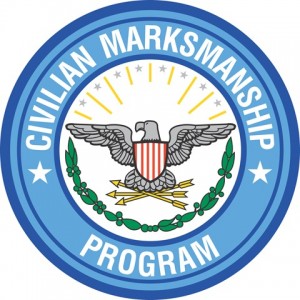



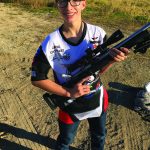
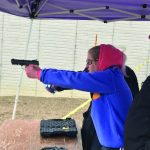
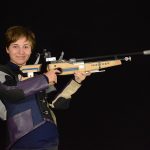




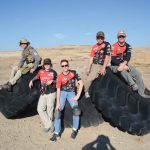
 (Originally printed in Volume 34 Spring 2019)
(Originally printed in Volume 34 Spring 2019) My dad happened to know a couple of people that love to pheasant hunt. So, it seemed like a good opportunity to try it. Jim Nelson and Mike Stone, two men that my dad hadn’t seen since high school, volunteered to take us out and show us the game of pheasant hunting. They have very well-trained dogs and knew where Fish and Game released the birds.
My dad happened to know a couple of people that love to pheasant hunt. So, it seemed like a good opportunity to try it. Jim Nelson and Mike Stone, two men that my dad hadn’t seen since high school, volunteered to take us out and show us the game of pheasant hunting. They have very well-trained dogs and knew where Fish and Game released the birds. I did not think that a 28-gauge would be up to the task of taking down a game bird, but my dad’s friend said it would, though I’d have to be accurate. There are obviously not as many BBs in a 28-gauge vs. a 12-gauge, so making them count was important.
I did not think that a 28-gauge would be up to the task of taking down a game bird, but my dad’s friend said it would, though I’d have to be accurate. There are obviously not as many BBs in a 28-gauge vs. a 12-gauge, so making them count was important.

 Jake Perry, 34, of Genoa, OH, led the TU-Class with a score of 592-27x. Scott Schindehette, 74, of Saginaw, MI, attained the High Senior title, as Davis Sodders, 20, of Baltimore, OH, was named High Junior for the second consecutive year.
Jake Perry, 34, of Genoa, OH, led the TU-Class with a score of 592-27x. Scott Schindehette, 74, of Saginaw, MI, attained the High Senior title, as Davis Sodders, 20, of Baltimore, OH, was named High Junior for the second consecutive year.  Jean Redicker, 55, of Vallonia, IN, earned High Woman,
Jean Redicker, 55, of Vallonia, IN, earned High Woman, Schindehette entered the record books for himself by narrowly breaking a decade-old T-Class High Senior record score of 589-21x, set back in 2009, with his score of 289-26x.
Schindehette entered the record books for himself by narrowly breaking a decade-old T-Class High Senior record score of 589-21x, set back in 2009, with his score of 289-26x. Overtaking the T-Class was junior Marissa Bensch, 19, of Stillwater, OK, who came out on top of over 200 other entrants with an aggregate score of 595-39x.
Overtaking the T-Class was junior Marissa Bensch, 19, of Stillwater, OK, who came out on top of over 200 other entrants with an aggregate score of 595-39x. Regulars to the National Matches, Brayden and Marissa both said the conditions during the match were fair, with typical summer temps for the area warming up competitors as the day went on. The heat brought more challenges for participants, but the brother-sister duo relied on their experiences to help them through the match.
Regulars to the National Matches, Brayden and Marissa both said the conditions during the match were fair, with typical summer temps for the area warming up competitors as the day went on. The heat brought more challenges for participants, but the brother-sister duo relied on their experiences to help them through the match. Brayden and Marissa came with the rest of their Oklahoma 4-H Shooting Sports Club. The growing group practices .22 rifle, shotgun, muzzleloader, archery and air rifle.
Brayden and Marissa came with the rest of their Oklahoma 4-H Shooting Sports Club. The growing group practices .22 rifle, shotgun, muzzleloader, archery and air rifle. hes, good friends taught us a couple things and we just kept shooting to the best of our abilities, which we took on pretty well.”
hes, good friends taught us a couple things and we just kept shooting to the best of our abilities, which we took on pretty well.” In other T-Class results at the 2019 Rimfire event, Nathan Tornow, 18, of Gibsonburg, OH, earned High 4-H Junior as Rachel Slizewski, 18, of Commerce, GA, took home the High Junior title. High Woman of the T-Class was junior Brenna Steger, 17, of Sandford, NC, who landed fourth overall.
In other T-Class results at the 2019 Rimfire event, Nathan Tornow, 18, of Gibsonburg, OH, earned High 4-H Junior as Rachel Slizewski, 18, of Commerce, GA, took home the High Junior title. High Woman of the T-Class was junior Brenna Steger, 17, of Sandford, NC, who landed fourth overall. Steger went on to earn the overall win in the O-Class with a score of 590-24x. Shannon Heist, 20, of Heath, OH, was named High Junior, and Timothy Ovaert, 60, of Notre Dame, IN, finished third overall with a score of 572-15x – claiming the High Senior title.
Steger went on to earn the overall win in the O-Class with a score of 590-24x. Shannon Heist, 20, of Heath, OH, was named High Junior, and Timothy Ovaert, 60, of Notre Dame, IN, finished third overall with a score of 572-15x – claiming the High Senior title. 



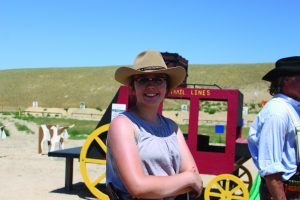
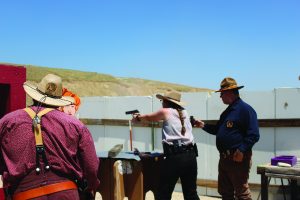
 I was really surprised how well my whole shoot went. I didn’t have any major mishaps that were going to set me back. I had a few errors and a procedural, which is where you shoot out of sequence, but those were my only mess-ups thankfully. My first year ever shooting state, the receiver bar in one of my pistols broke and cost me that stage, but nothing that bad happened this year!
I was really surprised how well my whole shoot went. I didn’t have any major mishaps that were going to set me back. I had a few errors and a procedural, which is where you shoot out of sequence, but those were my only mess-ups thankfully. My first year ever shooting state, the receiver bar in one of my pistols broke and cost me that stage, but nothing that bad happened this year!  State is by far one of my favorite shoots of the year. I get to meet tons of different shooters from all around. I even met another Macey, although her spelling was different than mine; it was Maisie. I almost never meet other people with my same name!
State is by far one of my favorite shoots of the year. I get to meet tons of different shooters from all around. I even met another Macey, although her spelling was different than mine; it was Maisie. I almost never meet other people with my same name!  This year, I ended up taking home first overall junior girls and junior girls state champion! I was so excited to even be able to shoot this summer, but the icing on the cake was being able to take home a shiny new buckle!
This year, I ended up taking home first overall junior girls and junior girls state champion! I was so excited to even be able to shoot this summer, but the icing on the cake was being able to take home a shiny new buckle! 

 Shooting this rifle is just plain fun! The practice you can achieve at a fraction of the cost of its big brother is significant. Shorten the distance you normally shoot, make the targets equally smaller, and off you go. Here is what some of the people who shot it thought:
Shooting this rifle is just plain fun! The practice you can achieve at a fraction of the cost of its big brother is significant. Shorten the distance you normally shoot, make the targets equally smaller, and off you go. Here is what some of the people who shot it thought: The Ruger Precision .22 LR is Ruger’s gift to long-range shooting in a small package. The great look and feel of the large-caliber precision rifle in just a .22 Long Rifle caliber. This rifle is good for all ages and for both new and experienced shooters, whatever your experience level may be. Ruger uses 4140 Chromoly steel machined receivers with a picatinny rail. The cold-forged barrel is threaded for muzzle brakes and suppressors. It has a one-piece, glass-filled nylon chassis with an adjustable shoulder stock assembly. The fully adjustable stock makes it the perfect setup for .22 LR precision shooting practice for your long-range shooting or just having a great time.
The Ruger Precision .22 LR is Ruger’s gift to long-range shooting in a small package. The great look and feel of the large-caliber precision rifle in just a .22 Long Rifle caliber. This rifle is good for all ages and for both new and experienced shooters, whatever your experience level may be. Ruger uses 4140 Chromoly steel machined receivers with a picatinny rail. The cold-forged barrel is threaded for muzzle brakes and suppressors. It has a one-piece, glass-filled nylon chassis with an adjustable shoulder stock assembly. The fully adjustable stock makes it the perfect setup for .22 LR precision shooting practice for your long-range shooting or just having a great time.
 Kaden
Kaden

 SASP is excited to watch as these athletes continue to participate in the International disciplines with hopes of one day seeing one of them standing on the podium and the American Flag is raised as they represent our county in international competition.
SASP is excited to watch as these athletes continue to participate in the International disciplines with hopes of one day seeing one of them standing on the podium and the American Flag is raised as they represent our county in international competition.
 By Ashley Brugnone, CMP Writer
By Ashley Brugnone, CMP Writer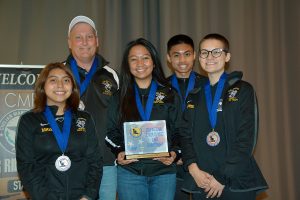 The event is free and open to the public, meaning anyone is welcome to visit and encounter some of the most talented junior marksmen in the country. Guests will also be able to personally see CMP’s electronic air gun targets, which are scored optically by internal LED lights. The range also features monitors at each firing point and large overhead monitors for spectators to keep track of scores.
The event is free and open to the public, meaning anyone is welcome to visit and encounter some of the most talented junior marksmen in the country. Guests will also be able to personally see CMP’s electronic air gun targets, which are scored optically by internal LED lights. The range also features monitors at each firing point and large overhead monitors for spectators to keep track of scores. To reward the hard work of dedicated junior athletes and coaches, the CMP administers thousands of dollars in monetary funds towards teams who qualify for the Regional events, with additional funds presented to qualifiers reaching the CMP National Championship. A scholarship check for $1,000 is also available for the top three highest-scoring senior athletes in both the sporter and precision classes at the National competition as a symbol of CMP’s continued support of junior marksmanship for the current generation and into the future.
To reward the hard work of dedicated junior athletes and coaches, the CMP administers thousands of dollars in monetary funds towards teams who qualify for the Regional events, with additional funds presented to qualifiers reaching the CMP National Championship. A scholarship check for $1,000 is also available for the top three highest-scoring senior athletes in both the sporter and precision classes at the National competition as a symbol of CMP’s continued support of junior marksmanship for the current generation and into the future. (COLORADO SPRINGS, Colorado – June 12, 2019) –
(COLORADO SPRINGS, Colorado – June 12, 2019) –  Tennessee natives Garrison and Broski might hail from the Volunteer State but neither of them was voluntarily stepping back from anything in the quest for top junior supremacy in Women’s Trap. Saturday it was Broski (Spring Hill) winning the Junior National title by two targets. Wednesday it was Garrison’s (Crossville) turn, claiming a second-straight NJOSC title by three targets over Broski. Claiming third each time behind the Tennessee duo was Krolikowski (Dannebrog, Nebraska), who had a true breakout performance in Colorado to earn a spot on USA Shooting’s Junior Olympic Squad. Garrison topped all qualifiers with a 118/125, four targets better than Broski.
Tennessee natives Garrison and Broski might hail from the Volunteer State but neither of them was voluntarily stepping back from anything in the quest for top junior supremacy in Women’s Trap. Saturday it was Broski (Spring Hill) winning the Junior National title by two targets. Wednesday it was Garrison’s (Crossville) turn, claiming a second-straight NJOSC title by three targets over Broski. Claiming third each time behind the Tennessee duo was Krolikowski (Dannebrog, Nebraska), who had a true breakout performance in Colorado to earn a spot on USA Shooting’s Junior Olympic Squad. Garrison topped all qualifiers with a 118/125, four targets better than Broski. By Andy Fink
By Andy Fink Even juniors should start thinking about college. Did you know that shooting sport scholarships are available from a variety of colleges and organizations for you to participate in?
Even juniors should start thinking about college. Did you know that shooting sport scholarships are available from a variety of colleges and organizations for you to participate in? The National Rifle Association (NRA) has a wealth of information on this. Check out:
The National Rifle Association (NRA) has a wealth of information on this. Check out: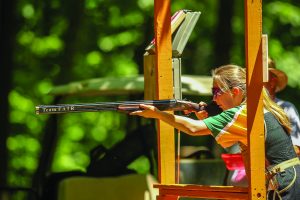 which allows you to filter by discipline and by state. If the college you want to go to isn’t listed, then call the school and ask them if they have a shooting sport program. Another NRA resource link is:
which allows you to filter by discipline and by state. If the college you want to go to isn’t listed, then call the school and ask them if they have a shooting sport program. Another NRA resource link is:  I mentioned scholarships in the paragraph above. Quite a few colleges have shooting scholarships, but they aren’t the only ones. Many shooting organizations and clubs have shooting scholarships, including the NRA, the National Shooting Sports Foundation (NSSF), Civilian Marksmanship Program (CMP), Scholastic Clay Target Program (SCTP), Scholastic Action Shooting Program (SASP), Daisy 4-H Shooting Sports Scholarship, the Single Action Shooting Society (SASS), Cowboy Fast Draw Association (CFDA), the Amateur Trapshooting Association (ATA), the American Legion, and many more.
I mentioned scholarships in the paragraph above. Quite a few colleges have shooting scholarships, but they aren’t the only ones. Many shooting organizations and clubs have shooting scholarships, including the NRA, the National Shooting Sports Foundation (NSSF), Civilian Marksmanship Program (CMP), Scholastic Clay Target Program (SCTP), Scholastic Action Shooting Program (SASP), Daisy 4-H Shooting Sports Scholarship, the Single Action Shooting Society (SASS), Cowboy Fast Draw Association (CFDA), the Amateur Trapshooting Association (ATA), the American Legion, and many more.




 MAGNOLIA –
MAGNOLIA – The new trap shooting team will be open to any interested SAU student and will compete in the Association of College Unions International (ACUI) Collegiate Clay Targeting Program. The sport has become increasingly popular among youth, and high school trap shooters in the region have already expressed an interest in choosing SAU to continue to compete at the next level.
The new trap shooting team will be open to any interested SAU student and will compete in the Association of College Unions International (ACUI) Collegiate Clay Targeting Program. The sport has become increasingly popular among youth, and high school trap shooters in the region have already expressed an interest in choosing SAU to continue to compete at the next level. 





